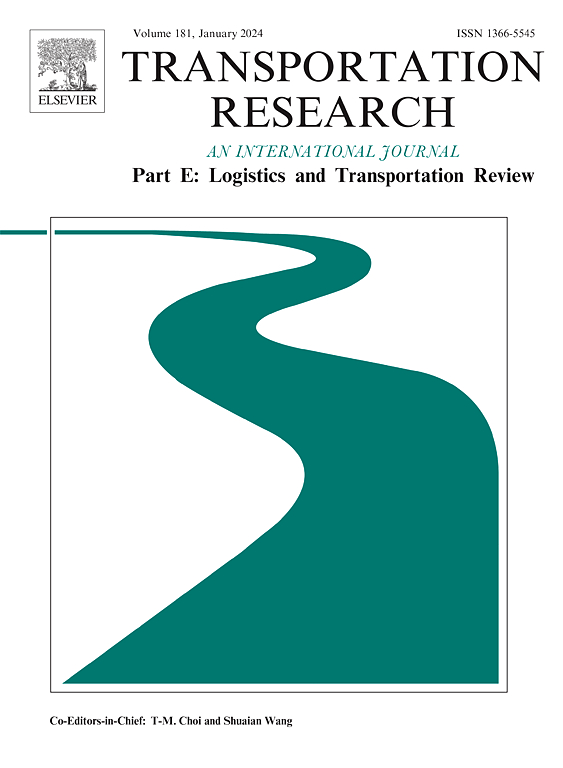Optimal design for an urban truck-drone collaborative delivery system enhanced with relay points
IF 8.8
1区 工程技术
Q1 ECONOMICS
Transportation Research Part E-Logistics and Transportation Review
Pub Date : 2025-09-24
DOI:10.1016/j.tre.2025.104425
引用次数: 0
Abstract
With the rapid expansion of e-commerce, the express sector has experienced significant growth, and most cities have developed comprehensive relay point (RP) infrastructures. While these facilities currently only support ground logistics, the advancement and adoption of drone technology offer the potential to enhance delivery efficiency. To address this, we propose a Relay Point-Enhanced Collaborative Truck-Drone Delivery Model (RPECTDDM) to leverage existing RP infrastructure for designing a more efficient ground-air integrated logistics system. By incorporating RPs for intermediate cargo transfers, the model optimizes: (i) RP selection, (ii) customer allocation between trucks and drones, and (iii) the routing of both trucks and drones. The problem is formulated as a mixed-integer linear programming model aimed at minimizing total costs, which include truck operations, drone deployment, and RP activation. A two-stage Adaptive Large Neighborhood Search (ALNS) algorithm is proposed to solve this computationally demanding problem. In the first stage, feasible solutions are generated using heuristic methods, while the second stage iteratively refines these solutions through destroy-and-repair operators tailored to the problem. Numerical experiments demonstrate the effectiveness of the proposed approach, achieving near-optimal solutions in reasonable computational times, even for large-scale scenarios. A real-world case study in Chengdu further highlights the advantages of the RPECTDDM, significantly reducing total costs and truck travel times compared to three benchmark models: Truck-Drone Collaborative Delivery Model (TDCDM), Relay Point Enhanced Truck Delivery Model (RPETDM), and Truck-Only Delivery Model (TODM). Specially, RPECTDDM achieves cost savings of up to 48.47 % and reduces truck travel time by 61.21 % compared to TODM. Sensitivity analyses underscore the importance of RP activation costs and drone endurance in operational planning. This study advances urban logistics by bridging the gap between theoretical models and practical implementation, offering a scalable, efficient framework for integrating trucks and drones in delivery systems.
基于中继点的城市卡车-无人机协同配送系统优化设计
随着电子商务的迅速发展,快递行业得到了显著的发展,大多数城市都建立了全面的中继点(RP)基础设施。虽然这些设施目前只支持地面物流,但无人机技术的进步和采用为提高配送效率提供了潜力。为了解决这个问题,我们提出了一个中继点增强型协同卡车-无人机交付模型(RPECTDDM),以利用现有的RP基础设施来设计一个更有效的地空综合物流系统。通过整合中间货物转移的RP,该模型优化了:(i) RP选择,(ii)卡车和无人机之间的客户分配,以及(iii)卡车和无人机的路线。该问题被描述为一个混合整数线性规划模型,旨在最小化总成本,包括卡车操作、无人机部署和RP激活。提出了一种两阶段自适应大邻域搜索(ALNS)算法来解决这一计算量大的问题。在第一阶段,使用启发式方法生成可行的解决方案,而第二阶段通过针对问题定制的销毁和修复算子迭代地改进这些解决方案。数值实验证明了该方法的有效性,即使在大规模场景下,也能在合理的计算时间内获得接近最优的解。在成都进行的实际案例研究进一步强调了RPECTDDM的优势,与三种基准模型(卡车-无人机协同交付模型(TDCDM)、中继点增强卡车交付模型(RPETDM)和卡车交付模型(TODM)相比,RPECTDDM显著降低了总成本和卡车行驶时间。特别是,与TODM相比,RPECTDDM节省了高达48.47%的成本,减少了61.21%的卡车行驶时间。敏感性分析强调了RP启动成本和无人机续航能力在作战计划中的重要性。这项研究通过弥合理论模型和实际实施之间的差距,为将卡车和无人机集成到交付系统中提供了一个可扩展的、有效的框架,从而推动了城市物流的发展。
本文章由计算机程序翻译,如有差异,请以英文原文为准。
求助全文
约1分钟内获得全文
求助全文
来源期刊
CiteScore
16.20
自引率
16.00%
发文量
285
审稿时长
62 days
期刊介绍:
Transportation Research Part E: Logistics and Transportation Review is a reputable journal that publishes high-quality articles covering a wide range of topics in the field of logistics and transportation research. The journal welcomes submissions on various subjects, including transport economics, transport infrastructure and investment appraisal, evaluation of public policies related to transportation, empirical and analytical studies of logistics management practices and performance, logistics and operations models, and logistics and supply chain management.
Part E aims to provide informative and well-researched articles that contribute to the understanding and advancement of the field. The content of the journal is complementary to other prestigious journals in transportation research, such as Transportation Research Part A: Policy and Practice, Part B: Methodological, Part C: Emerging Technologies, Part D: Transport and Environment, and Part F: Traffic Psychology and Behaviour. Together, these journals form a comprehensive and cohesive reference for current research in transportation science.

 求助内容:
求助内容: 应助结果提醒方式:
应助结果提醒方式:


